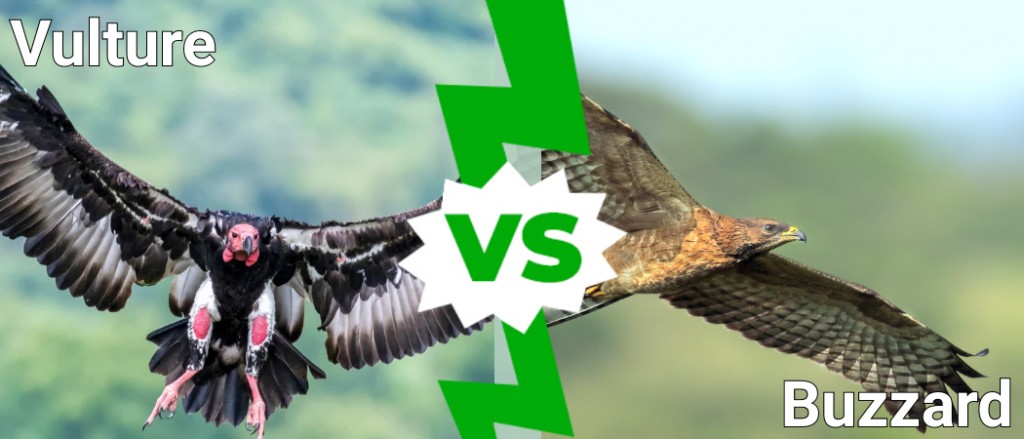
Buzzard vs Vulture
Buzzard vs Vulture When you hear the word “buzzard,” or “vulture,” a few images may come to mind: circling birds in the sky, scanning the ground for prey or carrion, perhaps a dry desert landscape. Although buzzards and vultures are often lumped together in conversation, they are actually distinct birds with differing behaviors, appearances, and habitats. In this article, we’ll delve into the fascinating world of buzzards and vultures, exploring their similarities, differences, and the roles they play in ecosystems around the world. Whether you’re a bird enthusiast, a nature lover, or simply curious, this comprehensive guide will shed light on these two often misunderstood birds.
Understanding Buzzard vs Vulture: An Overview

What Exactly is a Buzzard?
In North America, the term “buzzard” is often used to refer to vultures, particularly the turkey vulture. However, in Europe and other parts of the world, the buzzard is a bird of prey in the hawk family (Accipitridae), often belonging to the genus Buteo. These birds are more closely related to hawks than vultures, even though many people still confuse the two.
Buzzards typically have broad wings and relatively Buzzard vs Vulture short tails, making them perfectly adapted for soaring through the air in search of prey. Their diet consists mainly of small mammals like rabbits and rodents, but they’re opportunistic hunters and will eat birds, insects, and even carrion if necessary. Unlike vultures, which primarily scavenge, buzzards are skilled hunters and often rely on live prey for sustenance.
Types of Buzzards Around the World
There are many species of buzzards found throughout Buzzard vs Vulture the world, each with unique adaptations for their specific environments. The common buzzard (Buteo buteo), for example, is widely distributed across Europe and parts of Asia. Its adaptability has allowed it to thrive in various habitats, from forests to open countryside.
Another well-known species is the red-tailed buzzard (Buteo jamaicensis), which is commonly found in North America. This bird is famous for its striking red tail and is one of the most easily recognized birds of prey in the region. Despite being called a “buzzard” in Europe, this bird is more closely related to hawks, showcasing the confusing nature of common names in the birding world.
Behavior and Hunting Techniques
Buzzards are highly territorial birds, often occupying the Buzzard vs Vulture same hunting grounds for years if left undisturbed. They are patient hunters, frequently perching in high vantage points like trees or cliffs, where they can spot potential prey from a distance. Once they’ve identified a target, they dive down with impressive speed and precision to capture it.
They’re also known for their soaring abilities. Buzzards use thermal updrafts (rising columns of warm air) to glide effortlessly over large areas while expending minimal energy. This soaring behavior is one of the reasons they’re often mistaken for vultures, as both birds can be seen circling high in the sky.
Understanding Vultures: Nature’s Cleanup Crew
What Exactly is a Vulture?
Vultures are scavengers, and unlike buzzards, they rarely Buzzard vs Vulture hunt for live prey. Their primary role in the ecosystem is to consume carrion—dead animals—thus preventing the spread of disease. These birds have incredible adaptations for this specialized diet, including strong stomach acids that allow them to digest rotting meat without getting sick.
There are two main types of vultures: Old World vultures and New Buzzard vs Vulture World vultures. Old World vultures belong to the family Accipitridae (the same family as hawks and eagles) and are found in Africa, Europe, and Asia. New World vultures, on the other hand, belong to the family Cathartidae and are native to the Americas.
One of the most striking features of vultures is their bald heads. This unique trait helps them stay clean while feeding, as it prevents bacteria and other contaminants from sticking to feathers. While it may not be the most glamorous look, it’s incredibly practical for their lifestyle.
Types of Vultures: A Global Perspective
There are 23 species of vultures worldwide, and they come in various shapes and sizes. Some of the most iconic species include the Andean condor (Vultur gryphus) and the California condor (Gymnogyps californianus), both of which are among the largest flying birds in the world, with wingspans exceeding 10 feet. These massive birds are New World vultures and are famous for their graceful soaring abilities.
In the Old World, species like the griffon vulture (Gyps fulvus) and the Egyptian vulture (Neophron percnopterus) play similarly crucial roles in their ecosystems. While these birds may not be as large as the condors, they are still highly efficient scavengers that help clean up carcasses in the wild.
Scavenging Habits and Unique Adaptations
Vultures are incredibly specialized scavengers. Their sharp, hooked beaks are Buzzard vs Vulture perfect for tearing into tough hides, while their strong stomach acids allow them to safely consume meat that would make other animals sick. Many species also have a highly developed sense of smell, which helps them locate carcasses from great distances.
Interestingly, vultures also play an essential role in disease prevention. By Buzzard vs Vulture consuming dead animals, they help limit the spread of harmful bacteria and viruses that could otherwise infect living populations. In regions where vulture populations have declined, there’s often a corresponding increase in diseases like rabies and anthrax, as other scavengers (like feral dogs) take over the role of cleaning up carrion but aren’t as efficient.
Physical Differences: How to Tell Buzzards and Vultures Apart
Size and Wingspan
One of the easiest ways to distinguish between buzzards and vultures is by Buzzard vs Vulture comparing their size. Vultures, particularly species like the Andean condor or the griffon vulture, are often much larger than buzzards. For example, the wingspan of a common buzzard typically ranges between 4 to 5 feet, whereas a griffon vulture can have a wingspan of up to 9 feet or more.
Buzzards are more compact and muscular, built for agile hunting and quick, powerful dives. Vultures, on the other hand, have large, broad wings designed for soaring and gliding over long distances without much effort. This difference in body structure is closely related to their respective hunting and scavenging lifestyles.
Feather Patterns and Coloration
Buzzards and vultures also differ in their feather patterns and coloration. Buzzard vs Vulture Buzzards often have more varied and intricate patterns on their feathers, with shades of brown, white, and sometimes reddish hues (like the red-tailed buzzard). These patterns can help them blend into their surroundings, making them more effective hunters.
Vultures, in contrast, tend to have more uniform and often darker plumage. Many species are primarily black or dark brown, though some (like the Egyptian vulture) have lighter feathers. Vultures’ bald heads, a key distinguishing feature, help reduce contamination when feeding on carcasses.
Flight and Behavior in the Air
If you see a bird circling in the sky, you might be tempted to call it a Buzzard vs Vulture buzzard or a vulture without knowing which is which. While both birds share the habit of soaring, there are subtle differences in their flight patterns.
Buzzards tend to flap their wings more frequently and fly at lower altitudes compared to vultures. They often make short, rapid dives when hunting. Vultures, on the other hand, rely heavily on thermals to stay aloft, rarely flapping their wings. They are typically found soaring at higher altitudes for extended periods, scanning the ground for carrion.
Ecological Roles: The Importance of Buzzards and Vultures in Ecosystems
Buzzards: Versatile Predators
Buzzards are versatile hunters that play a crucial role in controlling Buzzard vs Vulture populations of small mammals, birds, and other prey species. By keeping rodent populations in check, they help maintain a balanced ecosystem and prevent the overpopulation of certain species, which can lead to crop damage and other environmental issues.
In some regions, buzzards also act as secondary scavengers, feeding on carrion when live prey is scarce. While they are primarily hunters, this opportunistic behavior allows them to survive in a wide range of environments and adapt to different food sources.
Vultures: Nature’s Clean-Up Crew
Vultures are often referred to as nature’s clean-up crew, and for Buzzard vs Vulture good reason. These scavengers play a critical role in the decomposition process by consuming dead animals that would otherwise rot and spread disease. Their stomach acids are incredibly potent, allowing them to digest rotting flesh without getting sick from the bacteria and toxins that would harm other animals.
In many parts of the world, vultures are essential for preventing Buzzard vs Vulture the spread of diseases like rabies, anthrax, and tuberculosis. By removing carcasses from the landscape, they help reduce the chances of these diseases being transmitted to other animals or even humans.
The Impact of Declining Vulture Populations
In recent years, vulture populations have been declining in various Buzzard vs Vulture parts of the world due to habitat loss, poisoning, and the illegal wildlife trade. This decline has had far-reaching consequences for ecosystems, as other scavengers (such as feral dogs and rats) are not as efficient at removing carcasses and often contribute to the spread of diseases.
For example, in India, a dramatic decline in vulture populations due to Buzzard vs Vulture the use of a veterinary drug called diclofenac has led to an increase in feral dog populations and a corresponding rise in rabies cases. This situation highlights the vital role that vultures play in maintaining the health of ecosystems.
Cultural Significance of Buzzards and Vultures
Buzzards in Mythology and Folklore
Throughout history, buzzards have been featured in various mythologies Buzzard vs Vulture and folklore. In ancient Greece, buzzards were considered symbols of strength and protection. The Romans, too, saw buzzards as omens of battle and power, often associating them with Mars, the god of war.
In modern culture, buzzards sometimes carry negative connotations, often being portrayed as ominous birds associated with death or bad luck. However, in many parts of the world, they are revered for their hunting prowess and role in controlling pest populations.
Vultures in Religion and Symbolism
Vultures hold significant cultural importance in various societies. In ancient Buzzard vs Vulture Egypt, the vulture was a symbol of protection and was often associated with the goddess Nekhbet, who was depicted as a vulture. The bird was seen as a guardian of the pharaoh and a symbol of maternal care and protection.
In Tibetan Buddhism, vultures play a key role in “sky burials,” a traditional funeral practice where the bodies of the deceased are left out for vultures to consume. This practice is based on the belief that the body is merely a vessel, and offering it to vultures is a final act of compassion that feeds other living beings.
Vultures also appear in many other cultures as symbols of renewal, Buzzard vs Vulture transformation, and even rebirth, due to their ability to take something dead and give it new life by consuming it.
Conservation Efforts: Protecting Buzzards and Vultures
Buzzard Conservation: Challenges and Successes
Buzzards have faced numerous threats over the years, including habitat loss, Buzzard vs Vulture hunting, and pesticide use. In many parts of the world, buzzard populations were severely depleted during the 20th century, as widespread use of pesticides like DDT affected their reproductive success.
However, conservation efforts have led to significant recoveries in some regions. In Buzzard vs Vulture Europe, for example, the banning of DDT and the implementation of protection laws have allowed common buzzard populations to rebound. Many conservationists now focus on habitat restoration and public education to ensure that buzzard populations remain stable in the future.
Vulture Conservation: A Global Priority
Vultures face even greater challenges, particularly in Africa and Asia, where Buzzard vs Vulture their populations have plummeted in recent decades. Poisoning, both intentional and accidental, is one of the leading causes of vulture deaths. Farmers sometimes poison carcasses to kill predators like lions or hyenas, but vultures, which feed on the same carcasses, are inadvertently killed in the process.
Conservation organizations around the world Buzzard vs. Vulture are working to protect vulture populations through various initiatives, including anti-poisoning campaigns, habitat protection, and captive breeding programs. One of the most successful efforts has been the banning of the veterinary drug diclofenac, which was responsible for the near extinction of several vulture species in India.
The Road Ahead: Future Challenges
Despite these efforts, the future of both buzzards and vultures remains uncertain. Climate change, habitat loss, and human-wildlife conflicts continue to pose significant threats to these birds. However, with continued conservation efforts and increased public awareness, there is hope that buzzards and vultures will continue to thrive in the wild.
Final Thoughts: Appreciating the Buzzard and Vulture
Buzzards and vultures, while often Buzzard vs. Vulture misunderstood, are fascinating birds that play crucial roles in maintaining the balance of ecosystems around the world. From the skilled hunting techniques of buzzards to the vital scavenging work of vultures, these birds are essential to the health of our planet. By learning more about their behaviors, habitats, and the challenges they face, we can better appreciate their importance and contribute to their conservation.
So the next time you see a bird soaring high in the sky, take a moment to observe its behavior. Is it a buzzard hunting for prey, or a vulture searching for carrion? Both birds are awe-inspiring in their own right, and by understanding the differences between them, we can appreciate the unique role each one plays in the natural world.





